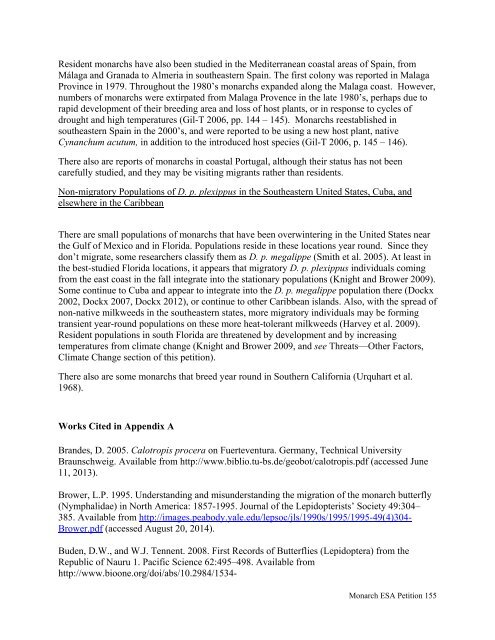monarch-esa-petition-final_61585
monarch-esa-petition-final_61585
monarch-esa-petition-final_61585
Create successful ePaper yourself
Turn your PDF publications into a flip-book with our unique Google optimized e-Paper software.
Resident <strong>monarch</strong>s have also been studied in the Mediterranean coastal areas of Spain, from<br />
Málaga and Granada to Almeria in southeastern Spain. The first colony was reported in Malaga<br />
Province in 1979. Throughout the 1980’s <strong>monarch</strong>s expanded along the Malaga coast. However,<br />
numbers of <strong>monarch</strong>s were extirpated from Malaga Provence in the late 1980’s, perhaps due to<br />
rapid development of their breeding area and loss of host plants, or in response to cycles of<br />
drought and high temperatures (Gil-T 2006, pp. 144 – 145). Monarchs reestablished in<br />
southeastern Spain in the 2000’s, and were reported to be using a new host plant, native<br />
Cynanchum acutum, in addition to the introduced host species (Gil-T 2006, p. 145 – 146).<br />
There also are reports of <strong>monarch</strong>s in coastal Portugal, although their status has not been<br />
carefully studied, and they may be visiting migrants rather than residents.<br />
Non-migratory Populations of D. p. plexippus in the Southeastern United States, Cuba, and<br />
elsewhere in the Caribbean<br />
There are small populations of <strong>monarch</strong>s that have been overwintering in the United States near<br />
the Gulf of Mexico and in Florida. Populations reside in these locations year round. Since they<br />
don’t migrate, some researchers classify them as D. p. megalippe (Smith et al. 2005). At least in<br />
the best-studied Florida locations, it appears that migratory D. p. plexippus individuals coming<br />
from the east coast in the fall integrate into the stationary populations (Knight and Brower 2009).<br />
Some continue to Cuba and appear to integrate into the D. p. megalippe population there (Dockx<br />
2002, Dockx 2007, Dockx 2012), or continue to other Caribbean islands. Also, with the spread of<br />
non-native milkweeds in the southeastern states, more migratory individuals may be forming<br />
transient year-round populations on these more heat-tolerant milkweeds (Harvey et al. 2009).<br />
Resident populations in south Florida are threatened by development and by increasing<br />
temperatures from climate change (Knight and Brower 2009, and see Threats—Other Factors,<br />
Climate Change section of this <strong>petition</strong>).<br />
There also are some <strong>monarch</strong>s that breed year round in Southern California (Urquhart et al.<br />
1968).<br />
Works Cited in Appendix A<br />
Brandes, D. 2005. Calotropis procera on Fuerteventura. Germany, Technical University<br />
Braunschweig. Available from http://www.biblio.tu-bs.de/geobot/calotropis.pdf (accessed June<br />
11, 2013).<br />
Brower, L.P. 1995. Understanding and misunderstanding the migration of the <strong>monarch</strong> butterfly<br />
(Nymphalidae) in North America: 1857-1995. Journal of the Lepidopterists’ Society 49:304–<br />
385. Available from http://images.peabody.yale.edu/lepsoc/jls/1990s/1995/1995-49(4)304-<br />
Brower.pdf (accessed August 20, 2014).<br />
Buden, D.W., and W.J. Tennent. 2008. First Records of Butterflies (Lepidoptera) from the<br />
Republic of Nauru 1. Pacific Science 62:495–498. Available from<br />
http://www.bioone.org/doi/abs/10.2984/1534-<br />
Monarch ESA Petition 155




